International business experts are seeing how structured frameworks can encourage both growth and efficient operations. The Entrepreneurial Operating System is considered one of the strongest approaches for arranging business processes, Guide to EOS Software, uniting teams and gaining stable success. The right technological setup is needed, not only a clear grasp of the framework, in order to make it work.
With increasing complexity, modern companies find it harder to run their operations, arrange their teams and understand what is happening with key business metrics. Arranging business management processes in the usual way is not enough to meet the strong integration and accountability needed for success. This is the moment where special software is needed to help you organize and apply standard approaches throughout your organization.
Properly selected tools can turn ideas into real processes, so every team member knows what they must do to support the company’s goals and keep pace with changes.
What is the Entrepreneurial Operating System (EOS)?
The Entrepreneurial Operating System provides a complete system guiding companies to achieve their goals using tested and effective processes. First introduced by Gino Wickman, this framework lays out a steady framework for running a business by emphasizing vision, people, data, issues, processes and traction.
The main principle is to promote transparency and responsibility everywhere in the organization. Using the Vision part, everyone involved learns what the company is striving toward and the reasons behind it. It is important in the People component to have employees in appropriate positions and make sure they have set expectations. Data helps with decision making by supplying objective facts and Issues deals with issues methodically. Consistency in operations is made possible by process and Traction helps remain on track by sticking to goals.
Its beauty comes from ease of understanding and usefulness for training. It introduces simple frameworks instead of complicated theories for companies to put into practice straight away. They use goal sessions every quarter, go over the company scorecard each week, follow planned meeting formats and have charts to define who is responsible for what. Once an organization implements these correctly, members notice improved communication, increased responsibility, stronger decision-making and faster growth toward their future plans.
Challenges of Implementing EOS Manually
- Coordination: Maintaining control of several teams and guaranteeing that different departments work together the same way is almost impossible without automated systems and a centralized view.
- Documentation: Trying to handle scorecards, accountability lists, meeting notes and progress updates manually takes up time and makes it likely for information to become outdated.
- Visibility: Compiling performance metrics, quarterly rocks and reviews of individual performance at the organization is mostly done manually as an repetitive task, making it almost impossible to have quick results.
- Consistency: Letting team members focus on reporting, following meeting arrangements and being accountable without templates and regular updates causes things to be done differently each time.
- Scalability: As soon as teams increase and tasks become more complex, it is extremely hard to manage things using only paper or spreadsheets.
- Integration: To oversee a business, managers commonly create connections by hand between functions and data which often leads to gaps in information.
Why Use EOS Software?
- Automation: Thanks to digital tools, administrative tasks connected to scorecards, meeting setup and tracking progress are reduced, so leaders can concentrate on critical decisions and implementation.
- Centralization: With cloud platforms, the entire organization uses a single source of data which prevents confusion that can happen when using older or incorrect versions.
- Accountability: With software, performance is clearly shown by teams and individuals which encourages people to take responsibility and confirms progress is being made.
- Efficiency: By improving workflows and using automated systems, managers and teams use less time on administration and focus more on activities that grow the business.
- Analytics: Business leaders use advanced reporting features to see trends, find any issues and act wisely using true data.
- Collaboration: Digital tools support easy communication and collaboration among different staff members, divisions and leaders which helps eliminate barriers that keep the organization from succeeding.
Key Features to Look for in EOS Software
- Integration: When solutions integrate well with current business tools, they help eliminate double entry and save time because data moves between platforms automatically.
- Scalability: The system must be able to grow with the organization, adding more users, new features and more complexity without the business needing to completely replace their software.
- Usability: Because the platform is user-friendly and navigation is streamlined, staff members are able to work with it quickly and easily.
- Customization: Technology allows organizations to change the software to fit their particular business world, work environment and procedures, without giving up necessary functions.
- Reporting: With the right analytics and visual tools, details in the data can support every part of the business for any period.
- Security: Using strong protection of data, granular access rights for users and compliant features, information that a business considers sensitive is kept protected and satisfies relevant industry rules and policies.
Top 8 EOS Software Tools in 2025
1. EOS Implementer 360™
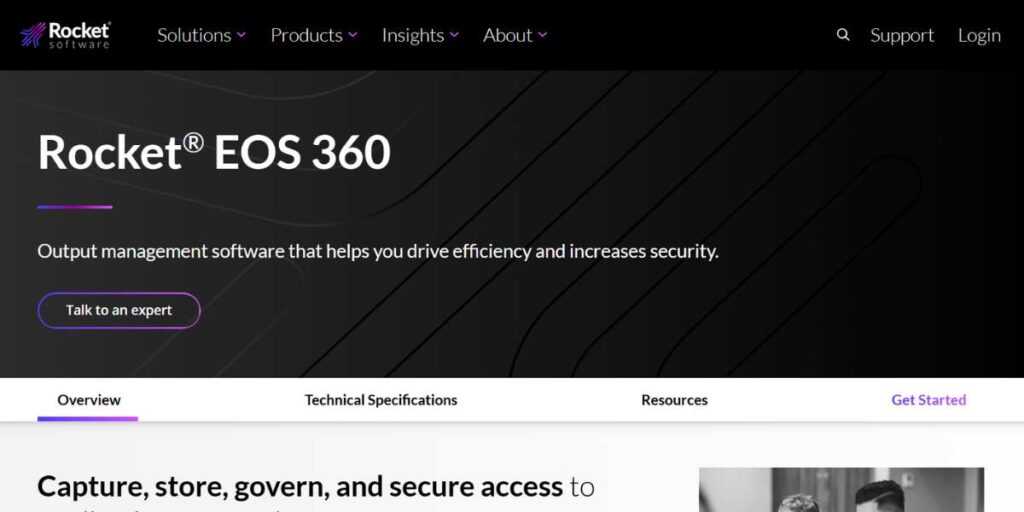
Rocket Software developed EOS Implementer 360™ as a way for groups to easily deal with data management and tasks when trying out the Entrepreneurial Operating System. StrongSuite Suite allows teams to easily handle business activities from a single place, connects well with Outlook and gives access to various business aspects from anywhere on a mobile device.
It is designed to have user-friendly tools which means anyone running a business, regardless of their technical skills, can use it. With its automated admin tasks and strong data management tools, EOS Implementer 360™ support businesses in tracking their success and takes some IT tasks off their plates. Access and usage of the tool are consistent everywhere and on any type of device it is opened on.
Key Services Offered:
- Dashboard Interface Management
- Business Application Integration
- Mobile Device Accessibility
- Administrative Task Automation
- Data Resource Management
Pros:
- User-Friendly Interface Design
- Seamless Integration Capabilities
- Mobile Remote Access
- Automated Task Processing
- Effective Performance Monitoring
Cons:
- Limited Output Management
- Bandwidth Processing Dependencies
- Specific Implementation Requirements
- Narrow Functionality Focus
- Custom Integration Needs
Pricing: $5,000 to $50,000 or more per year
Ratings: 4.1/5
Link: https://www.rocketsoftware.com/en-us/products/eos-360
2. Bloom Growth™ (formerly Traction Tools®)
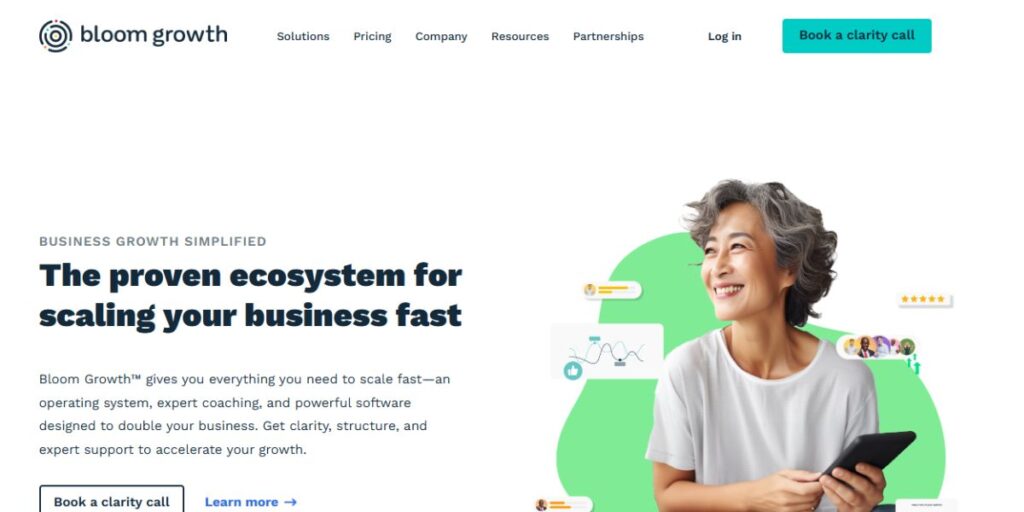
Bloom Growth™ grew out of Traction Tools® and serves as a powerful business growth system to increase how efficiently various parts of an organization work. Using the platform, you can handle meetings, form business models and monitor progress using the Entrepreneurial Operating System. My team can use streamlined templates to set up meetings, gain access to the dashboard easily and distribute tasks to all team members.
For the benefit of small companies, Bloom Growth™ places a strong emphasis on improving efficiency as well as setting specific (or custom) performance metrics and detailed reporting tools. The clear organization of this platform makes running key business processes easy and keeps teams responsible. Because it covers most framework needs, it can support organizations looking to achieve better results and team teamwork by following defined processes and monitoring performance.
Key Services Offered:
- Meeting Management Templates
- Dashboard Process Access
- Task Distribution Systems
- Performance Tracking Tools
- Custom Reporting Features
Pros:
- Comprehensive Framework Coverage
- Optimized Meeting Efficiency
- Clean Dashboard Design
- Enhanced Team Accountability
- Streamlined Essential Procedures
Cons:
- Text-Heavy Interface Design
- Regular System Crashes
- Technical Setup Requirements
- Limited Visual Charts
- Spreadsheet-Heavy Data Display
Pricing:
- $500
Ratings: 4.5 out of 5
Link: https://www.bloomgrowth.com/
3. EOS Scorecard™

One of the main tools developed by EOS Worldwide to support comprehensive organizational implementation is the EOS Scorecard. With this downloadable guide, you get directly advice on the core business activities and how to set clear duties for weekly progress tracking and accountability. This tool is designed to be simple and focused, so that measurable results are reached by tracking outcomes systematically.
Since issues from sessions are worked on during meetings and daily work discussions, EOS issues fit well into regular company structures. The scorecard enables users to select what success means for their organization. As an actual framework design, it matches approved methodology standards and integrates readily with common review processes. Although basic, the EOS Scorecard™ is essential for tracking goals which keeps EOS implementation focused and on the right path.
Key Services Offered:
- Weekly Metrics Tracking
- Responsibility Assignment Systems
- Measurable Outcome Focus
- Meeting Structure Integration
- Customizable Metrics Selection
Pros:
- Completely Free Tool
- Simple Design Adoption
- Direct Methodology Alignment
- Easy Process Integration
- Proven Framework Principles
Cons:
- Basic Functionality Limitations
- Manual Update Requirements
- No System Automation
- Limited Advanced Features
- No Business Integration
Pricing: $50,000 per year
Link: https://www.eosworldwide.com/scorecard-download
4. Vision/Traction Organizer™
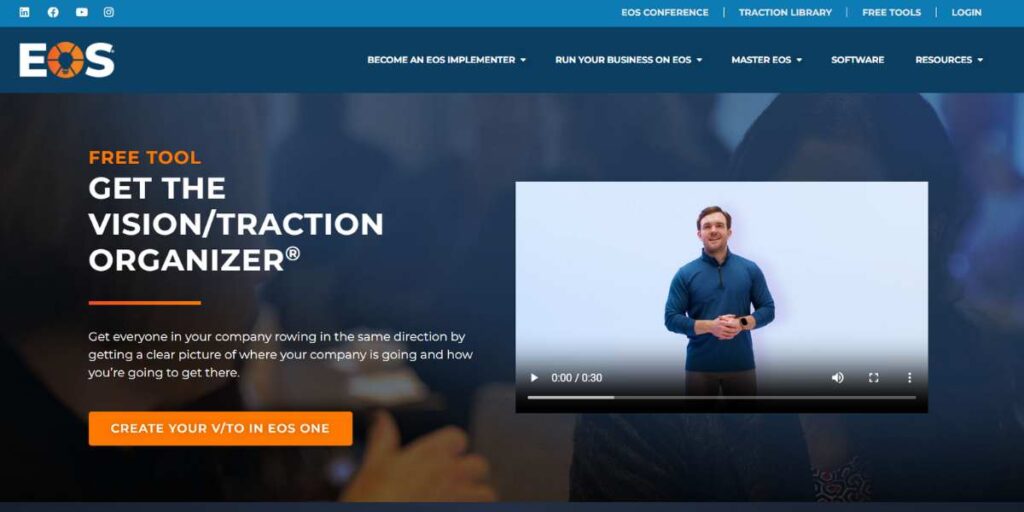
The Vision/Traction Organizer™ is a key free tool from EOS Worldwide designed to take complex company vision and turn it into written actions and steps. The tool supports organizations in deciding where they are headed and what actions to take to achieve desired goals. Dedicated development on the vision page lists the main values, key areas and goals and traction page development narrows the focus to top annual priorities and rocks. The tool enables managers to identify issues beforehand and provides templates so planning can be done in a structured way.
Because of its clear format, everyone in the organization can communicate and stay aligned. The creators of frameworks regard the Vision/Traction Organizer™ as an important tool, as it cuts the expenses usually attached to strategic planning and helps make the process more manageable.
Key Services Offered:
- Vision Page Development
- Traction Page Creation
- Issue Identification Planning
- Strategic Planning Simplification
- Documentation Format Standardization
Pros:
- Essential Framework Tool
- Free Implementation Access
- Structured Planning Approach
- Clear Communication Format
- Team Alignment Facilitation
Cons:
- Static Document Format
- Limited Collaboration Features
- No Dynamic Updates
- No Business Integration
- Minimal Revision Capabilities
Pricing: Free, $10 per month
Link: https://www.eosworldwide.com/vto-download
5. EOS Accountability Chart™
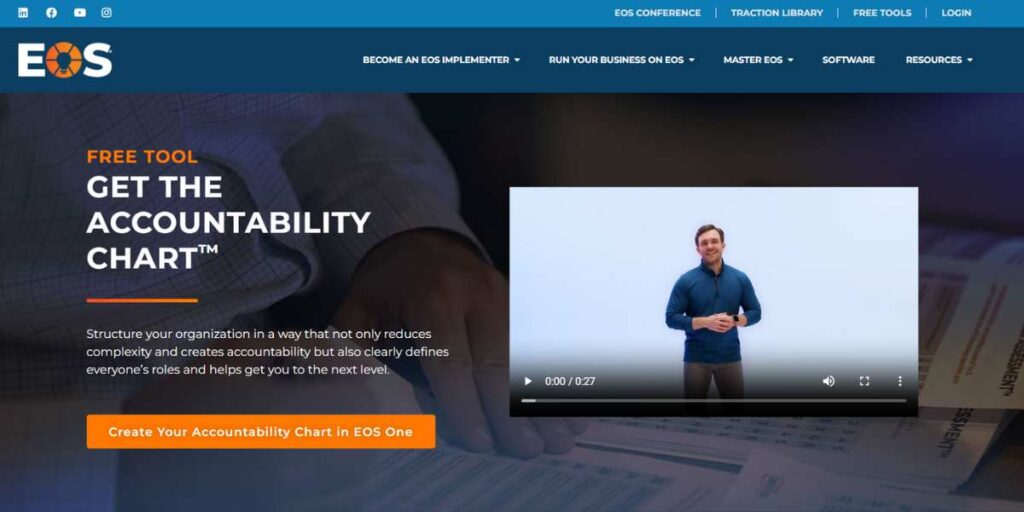
Black’s EOS Accountability Chart™ changes classic organizational charts by replacing only reporting relationships with specific guidelines for accountability and responsibility. It supports companies by helping them develop a sense of responsibility at every level and ensures everyone knows what is expected of them. Besides the standard lines of command, the chart contains specific actions under individual responsibility that can be up to five per role. By outlining how company roles and tasks relate, teams will gain clear insight and help shape team culture through clear guidelines.
Key Services Offered:
- Role Responsibility Definition
- Individual Accountability Assignment
- Visual Relationship Mapping
- Culture Development Support
- Scalable Growth Structure
Pros:
- Improved Performance Ownership
- Clear Role Definition
- Visual Communication Format
- Cultural Development Support
- Reduced Operational Confusion
Cons:
- Significant Development Investment
- Regular Update Requirements
- Leadership Commitment Dependency
- Implementation Training Needs
- Time-Intensive Initial Setup
Pricing: $10/month
Ratings:
6. Rocks Management
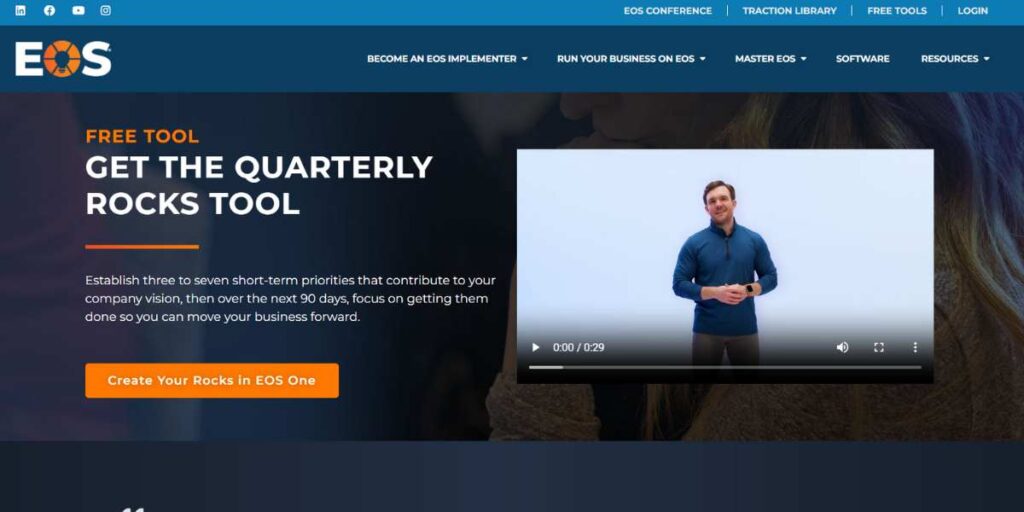
The Entrepreneurial Operating System relies on rocks management because it helps set key priorities quarterly and ensures they are being achieved. This method changes regular project management by putting main strategies at the forefront that relate closely to what the organization hopes to achieve in the long run. Managers are instructed to select 3-7 important goals each quarter to avoid using resources in many places at once. The rock balances what the business wants to achieve with its larger vision, also planning out tasks and roadmaps for what needs attention. Roles at every stage of resource allocation are designed to fulfill tasks and check-ins and reviews help maintain proper execution.
Key Services Offered:
- Quarterly Priority Setting
- Strategic Vision Connection
- Scalable Task Development
- Resource Allocation Flexibility
- Progress Tracking Systems
Pros:
- Strategic Focus Maintenance
- Manageable Achievement Timeframes
- Direct Vision Alignment
- Resource Flexibility Accommodation
- Long-Term Success Orientation
Cons:
- Priority Limitation Discipline
- Accurate Identification Dependencies
- Resource Allocation Accuracy
- Team Adjustment Requirements
- Success Implementation Dependency
Pricing: Free version
Ratings:
READ ALSO : Treading business idea
7. Delegate and Elevate™

The approach from Delegate and Elevate™ allows people and teams to achieve peak performance by focusing on their strengths and being motivated. The process of using this comprehensive tool results in improved efficiency, more satisfied employees and better performance for the organization. A four-quadrant analysis is used to examine what skills and tasks the person already has and how much enjoyment is linked with them. With delegation guidance, leaders make sure the right tasks are reassigned or removed and also guide employees on using their time and abilities well. Conference software can further support this approach by streamlining communication and task alignment. Checking how the organization operates regularly guarantees it is always aligned and efficient.
Key Services Offered:
- Task Evaluation Systems
- Four-Quadrant Analysis Framework
- Delegation Guidance Prioritization
- Talent Optimization Strategies
- Regular Review Processes
Pros:
- Improved Job Satisfaction
- Increased Organizational Efficiency
- Clear Delegation Framework
- Professional Development Support
- Strength-Interest Focus Optimization
Cons:
- Honest Self-Assessment Requirements
- Management Commitment Dependencies
- Potential Resource Gaps
- Implementation Change Needs
- Individual Challenge Variations
Pricing: Contact
Link:
8. The Issues Solving Track
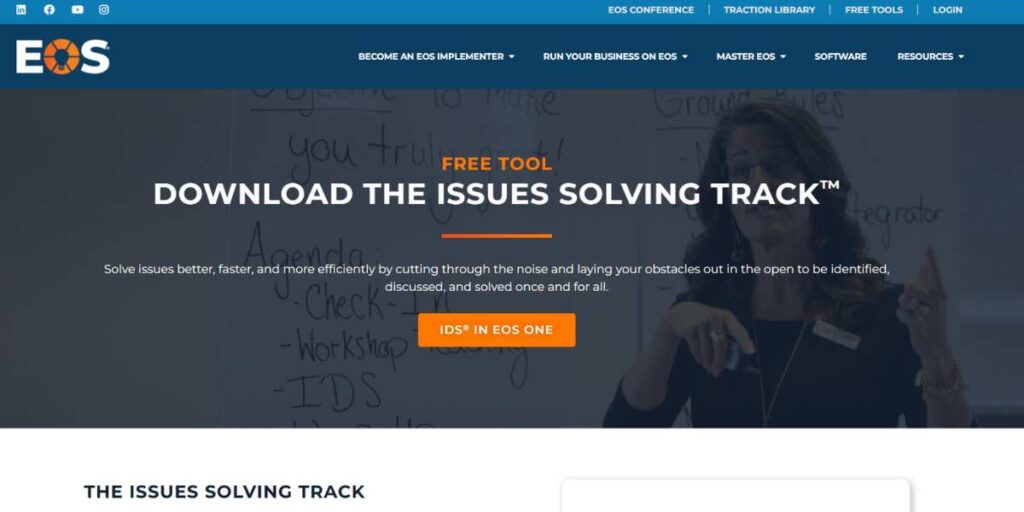
Using The Issues Solving Track helps organizations using the Entrepreneurial Operating System gather important information needed for decision-making and ongoing improvements. With robust tools, companies can make certain internal and external groups are at the core of every planning and action step. Customers and employees are both asked to give feedback and the system can also be used to accurately find and solve problems regarding rocks. Responses that can be monitored and arranged give helpful results and regular feedback maintains progress in improving.
Key Services Offered:
- Systematic Feedback Collection
- Rock Integration Processes
- Response Management Systems
- Regular Improvement Cycles
- Stakeholder Engagement Strategies
Pros:
- Objective Decision-Making Input
- Stakeholder Satisfaction Demonstration
- Improvement Opportunity Identification
- Stronger Relationship Building
- Active Listening Response
Cons:
- Feedback Action Commitments
- Criticism Challenge Management
- Response Rate Dependencies
- Honest Participation Requirements
- Implementation Platform Variations
Pricing: $23.50 per user per month
Link: https://www.eosworldwide.com/issues-solving-track-download
Tips for Choosing the Right EOS Software
Assessment:
Assess the current business activities, the size of your team and what is required for implementation, so the tools you select address genuine problems and not just what seems to be missing.
Integration:
Choose systems that easily link to your current business tools so you can avoid crossing or duplicating information, resulting in both time-wastage and inconsistency.
Budget:
Plan the budget clearly to account for setup costs, regular fees, implementation and training, so chosen solutions last as the company develops.
Scalability:
Pick software solutions that help your company grow, deal with more users, include more tools and support greater complexity, all with minimal expense or effort.
Support:
Assess how much support your vendor provides, if they offer good training, if you can access their documentation and how involved the community is to help implement and improve your solutions.
Trial:
Evaluate software with sample team members and regular business operations with free trials, demos and pilot programs.
Conclusion
Even though the Entrepreneurial Operating System has helped many organizations, its successful use depends on setting up the proper technological framework. To be successful, companies need to rely on processes rather than only manual actions for strong coordination, responsibility and visibility.
Choosing the right software enables companies to change ideas into real operations that can be measured. The main goal is to use systems or tools that assist the six basics and can be adjusted as your organization grows and changes.
The EOS works well when it is used in a consistent way, more than when you have all the perfect resources. Address your main concerns first with technology and as your team gets more skilled, build out your technology systems. With the right tools, you achieve more efficiency, smarter decisions, better responsibility and faster progress towards what you want your organization to become.
READ ALSO :
- Best Robinhood Alternatives
- TikTok Alternatives to Explore
- YouTube Vanced Alternatives
- Character AI Alternatives
- PDF Drive Alternative
FAQs
In what ways Entrepreneurial Operating System differs from regular project management software?
The Entrepreneurial Operating System is designed to keep everything in a business working together and well-managed, whereas project management software is intended only for task coordination and keeping track of deadlines.
Can Entrepreneurial Operating System be used successfully by small businesses?
Yes, EOS Worldwide offers many solutions that work well for smaller teams and budgets and they offer free tools through their website to support your first steps.
How much time does it usually take to set up EOS software effectively?
Depending on how big and detailed the organization is, it can take its time to implement, but many businesses enjoy early advantages in 30-60 days and complete adoption usually requires 6 to 12 months.
Can I use only some of the EOS tools or do I have to cover all of them?
First, use helpful tools that focus on areas where you have the most difficulty, then add more tools as your software implementation develops and your team becomes used to following processes.
What happens if the EOS software I picked doesn’t match my business needs?
Most vendors give trials or money-back choices and because ConnectedEast is modular, swapping modules won’t disrupt your whole system or delete your progress.
